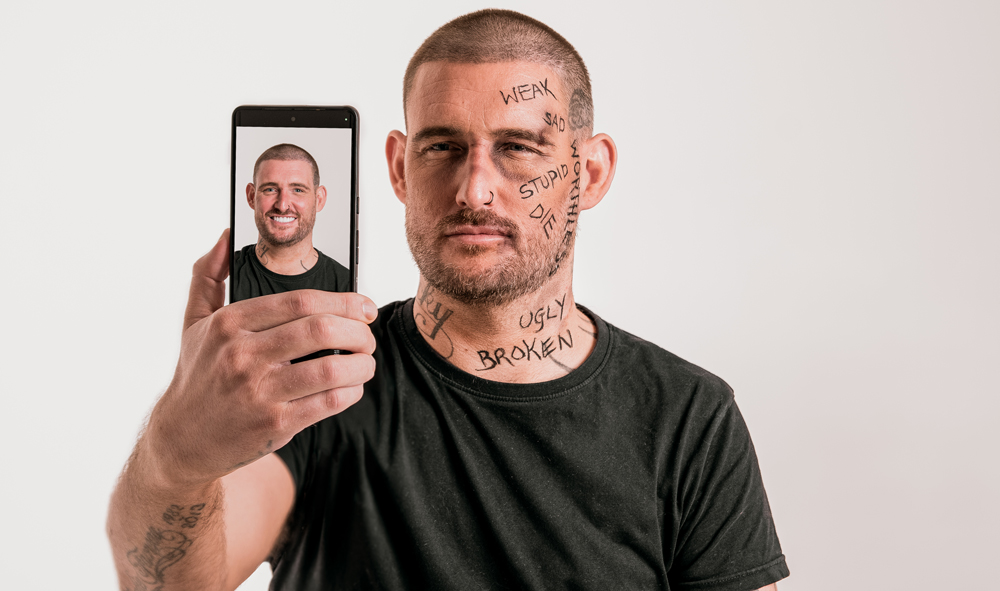You suspect your client is suffering domestic abuse. So, what do you do next? Celebrity hairstylist Sam Kerswell has first-hand experience
Concerned for the welfare of your colleague or client? Celebrity hairstylist Sam Kerswell shares his first-hand experience, so you know how best to help.
You suspect your client is suffering domestic abuse. So, what do you do next? Celebrity hairstylist Sam Kerswell has first-hand experience
Concerned for the welfare of your colleague or client? Celebrity hairstylist Sam Kerswell shares his first-hand experience, so you know how best to help.

Sam Kerswell, photographed by Lynett Genockey of Harplette Photography with make-up by Tracy Graham
It’s no secret that the hair salon is seen as a safe space by clients – it’s a chance for them to vent, divulge details from their personal lives and chat to hairdressers like old friends. Often, hairdresse rs consider themselves to be agony aunts, but what happens when it goes beyond discussing a new relationship or family drama?
A hair salon can be a lifeline for someone experiencing abuse and may provide a safe place to seek help, be it as a client or as an employee at the space. For hairdresser Sam Kerswell, a survivor of domestic abuse, his clients knew something was up because of him repeatedly cancelling or rescheduling appointments. When they eventually got to see Sam in person, they noticed how his physical appearance had changed because of the abuse he was suffering at home.
Like so many victims of domestic abuse, Sam was afraid to speak out against his abuser, with those in his life none the wiser as to what was causing the bruises, weight loss, and much more besides. Fast forward a year, and he’s now sharing his story to raise awareness and help anyone else who is suffering in silence.
If you’re concerned about a colleague or client, here Sam shares the signs you should be looking out for, and what to do if you’re wanting to offer support but unsure how to help.
“If you’re concerned about a colleague or client, here Sam shares the signs you should be looking out for, and what to do if you’re wanting to offer support but unsure how to help.”
10 things to look out for
1. Physical injuries: Notice unexplained bruises, cuts, or marks, especially if they occur frequently or seem to be escalating in severity.
2. Changes in behaviour: Look for sudden changes in mood, anxiety, or withdrawal from social interactions.
3. Isolation: If a co-worker or client becomes increasingly isolated, avoids social gatherings, or makes excuses to not participate in group activities, it could be a sign of controlling behaviour from an abusive partner.
4. Excessive absences or tardiness: Consistent tardiness or unexplained absences could indicate the need to hide injuries or emotional distress caused by domestic abuse.
5. Unusual financial strain: Notice if a co-worker or client suddenly experiences financial difficulties, such as requesting pay advances, selling personal items, or borrowing money frequently. This could be a result of financial control or manipulation by an abuser.
6. Fearfulness or nervousness: Pay attention to signs of fearfulness, nervousness, or being easily startled, especially if they seem to be in the presence of their partner.
7. Overly controlling partner: If a co-worker or client’s partner exhibits overly controlling behaviour, such as constantly calling or texting, monitoring their whereabouts, or restricting their communication with others, it could be a red flag.
8. Unexplained excuses or cover-ups: Be wary of inconsistent or implausible explanations for injuries, missed work, or changes in behaviour. Unexplained weight loss and excuses as to why is also an indicator as some abusers limit food intake.
9. Uncharacteristic clothing choices: Notice if a co-worker or client wears clothing that seems inappropriate for the weather or situation, which could be an attempt to hide physical injuries.
10. Expressions of fear or concern: If they confide in you about feeling afraid or concerned about their safety at home, take their words seriously and offer support and resources for help.
“If you’re concerned about a colleague or client, here Sam shares the signs you should be looking out for, and what to do if you’re wanting to offer support but unsure how to help.”


How to help
1. Choose a private and safe space: Initiate the conversation in a private setting where the individual feels comfortable and safe. This could be a quiet office or a secluded area away from others.
2. Express concern and support: Begin the conversation by expressing genuine concern for their well-being. Let them know that you’ve noticed certain signs or behaviours that have raised concerns and that you are there to support them.
3. Listen actively: Allow the individual to share their thoughts, feelings, and experiences without interruption. Practice active listening by maintaining eye contact, nodding, and providing affirmations to show that you are engaged and empathetic.
4. Avoid judgment and blame: Refrain from making assumptions or placing blame on the individual for their situation. Instead, focus on validating their experiences and feelings while offering reassurance that they are not alone, and that help is available.
5. Offer resources and assistance: Provide information about available resources, such as domestic violence hotlines, counselling services, legal assistance, and support groups. Offer to assist them in accessing these resources if needed, while respecting their autonomy to make their own decisions.
6. Respect confidentiality: Assure the individual that any information they share with you will be kept confidential to the extent possible, while also explaining any legal or professional obligations you may have to report certain disclosures of abuse.
7. Create a safety plan: Work together to develop a safety plan tailored to their specific situation, which may include steps to ensure their immediate safety, such as identifying safe places to go or establishing a code word to signal for help.
8. Follow up and check in: Continue to offer support and check in with the individual regularly to see how they are doing. Let them know that you are there for them whenever they need someone to talk to or if they need assistance in any way.
By approaching these conversations with empathy, understanding, and a commitment to supporting the individual’s autonomy and well-being, you can help clients and colleagues feel empowered to seek help and make positive changes in their lives.
Related
“I can’t Imagine A World In Which I Would Have A Salon And Not Have An Apprentice”
Stripe Colour Studio on why more salons need to invest in the next generation
“People love beauty. That makes me happy, to know that so many people are being impacted” – Ali Pirzadeh on the power of hair
2024 Most Wanted Session Stylist Ali Pirzadeh talks about his heritage, creating compelling narratives through hair and why routine keeps him grounded
“Quite Frankly, The Manufacturers Have Abandoned This Industry” – Why Boots Was A Step Too Far For Keune Boss Darren Potter
Should pro hair brands cut out the hair pro and sell direct to the consumer? Darren Potter doesn’t think so.










